What are 'Fatah-II' rockets? Guided Multiple Launch Rocket System that Pakistan can use to target Delhi explained
 Pakistan is certain that its 'Fatah-II' can beat India's S400 air defence system in combat | X
Pakistan is certain that its 'Fatah-II' can beat India's S400 air defence system in combat | X
Pakistan tried to target New Delhi with projectiles that were shot down by Indian air defence systems in Haryana's Sirsa, unconfirmed news reports said. The Russian S 400 systems were deployed by India to successfully gun down the 'Fatah-II' guided missiles that Pakistan launched after tensions soared between the neighbours post-Operation Sindoor.
Interestingly, earlier reports had quoted Pakistani military sources as saying that 'Fatah-II' was brought into existence to particularly challenge India's S 400 systems. The ballistic missiles were potent enough to take out the Russian air defence systems in war as they could fly low to confuse the Russian-made radars, Pak military bases believed.
ALSO READ | Operation Sindoor: ‘Over 100 terrorists killed; Pakistan Army lost 35-40 personnel,’ says DGMO
According to Wikipedia, The Fatah-II is mounted on a Chinese Taian TAS5450 eight-wheel drive chassis, providing enhanced mobility and operational flexibility.
Equipped with advanced avionics and inertial satellite navigation systems, the Fatah-II boasts high precision with a Circular Error Probable (CEP) under 10 meters. CEP is the radius of a circle, centered on the intended target, within which 50% of a missile's warheads or projectiles are expected to land. Inertial satellite navigation systems, meanwhile, guide missiles accurately to their targets, especially over long ranges or in hostile environments.
ALSO READ | India used BrahMos missiles during Operation Sindoor, reveals Yogi Adityanath
Although the attempt to strike New Delhi was thwarted at least a 100 kilometres away, it can't be taken lightly that Islamabad now bears arms that can reach the Indian heartlands. While there is not much information available on the open domain about the Fatah-II system, here are five things to know about the prized possession of the Pakistani arsenal:
1. The Fatah, not to be confused with the Iranian hypersonic medium-ranged 'Fattah' ballistic missiles, are Pakistani-built guided rocket launchers. While Fatah-I was first testfired in 2021, the more advanced Fatah-II is said to have the capability to travel 400 kilometres.
2. They were primarily developed to conduct deep strike missions (targeting and destroying high-value enemy assets located deep within enemy territory). A short sensor-to-shooter response time and precision strike capability are the salient features of these rockets. 'Short sensor-to-shooter response time' refers to the rapid sequence from detecting a target (sensor) to engaging it with weapon systems (shooter). The faster this is executed, the harder it is for incoming enemy projectiles to evade. Swift transition is crucial while dealing with time-sensitive or mobile airborne threats.
ALSO READ | Operation Sindoor: Why a fragile pause in India-Pak firing across LoC doesn’t make it 'ceasefire'?
3. A report by Defence Security Asia said that according to Pakistan, the Fatah-II's unique flight trajectory makes it difficult to detect enemy radars and thus is capable of challenging even the most modern air defence systems that its neighbouring countries possess. It added that sources in Islamabad agreed that Fatah-II was developed particularly to “challenge” India's Russian-made S-400 air defence system.
4. It was reported that Fatah-II didn't cost Islamabad a bomb. They fall under the Guided Multiple Launch Rocket System (G-MLRS category). Its low production and operational costs make it affordable when compared to high-maintenance Short Range Ballistic Missiles (SRBMs).
ALSO READ | Did Pakistan just boast about its involvement in Pulwama terror attack? Pak military official's acknowledgement exposes liesA
5. The commissioning of Fatah-II for the first time, has made Pakistan capable of striking India's military and air bases, ammunition depots, bridges, logistics hubs and other crucial destinations with conventional artillery munitions, The Diplomat said in a 2024 report. The article also claimed that Pakistan’s Army considers it a perfect conventional counterforce weapon to repel any Indian advancement through the ground.
Defence